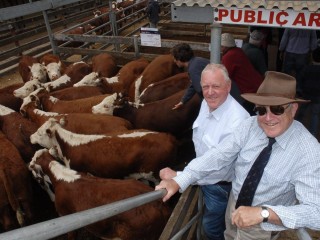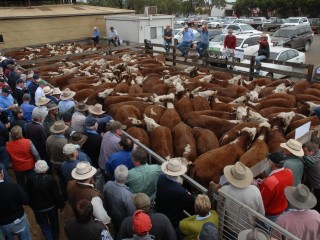 With dry conditions prevailing throughout most of eastern Australia this summer, it was clear in the lead-up to Christmas that this year’s run of southern weaner sales would contrast strongly with recent years.
With dry conditions prevailing throughout most of eastern Australia this summer, it was clear in the lead-up to Christmas that this year’s run of southern weaner sales would contrast strongly with recent years.
Based on seasonal and market realities, it was increasingly obvious that vendors would face returns of 40-50 cents per kilogram liveweight less than 12 months ago.
Wishes for a festive season downpour somewhere in the eastern states to provide even a hint of grass demand were answered in the cruellest possible fashion.
Instead of rain, the south-east of the continent recorded one of the hottest start to a year on record.
Fires (or at least the real threat of a blaze), parched paddocks and the blistering heat ensured that demand from speculative buyers looking to put calves back out to graze was further weakened in the first fortnight of the new year.
But as ever, the sales go on.
Tens of thousands of calves have already been sold in a belt from Wodonga in Victoria’s north-east right through the Western District and into South Australia.
Hamilton, which together with nearby Casterton, offers big numbers of noted breeders’ cattle, mostly Angus and Hereford, has endured its toughest run of weaner sales for several years.
Ahead of the first sales, many agents were tipping a selling range for most steers of below 175 cents a kilogram. This turned out to be slightly pessimistic, with quality pens offering weight selling well in advance of 180c/kg. Steers with EU-accreditation once again offered reward for vendors, with agents quoting a 10-15c/kg premium, pushing some pens above 200c/kg, with plenty of others from 190c/kg.
Hamilton-based agent John Ellis, JM Ellis & Co, has both sold and bought cattle in the early January sales.
“The calves have been more sensibly priced this year, which has provided some room for buyers to operate,” Mr Ellis said.
“In recent years, weaner prices have really put the squeeze on fatteners. This year, that cream that has been there due to good seasonal conditions just wasn’t a factor.”
Mr Ellis was active at the Hamilton’s independent agents’ sale on January 9, where his client John Wyld, Harrow, purchased the top-priced pen at the sale, 100 Herefords in from the McClure family, Mooree, also at Harrow. The top draft of McClure steers averaged 385 kilograms liveweight and were secured for 201c/kg or $773.85 a head.
Mr Ellis said he thought the results from the independent sale were in line with market and seasonal conditions.
“I thought our weaner sale was pretty solid and I hope vendors were happy.
“We did all we could in the circumstances and were satisfied with the results, especially when you consider the state of the market. And given the dry conditions, we were realistic about what to expect.
“Let’s just say I’m happy it’s behind me. I’m relieved it’s all over.”
 The Western District sales have been comparable with those at Wodonga and elsewhere in Victoria’s north-east, with the anticipated premium for heavier steers and those with EU accreditation a common factor.
The Western District sales have been comparable with those at Wodonga and elsewhere in Victoria’s north-east, with the anticipated premium for heavier steers and those with EU accreditation a common factor.
Demonstrating the relatively weak restocker demand, heifers and lighter steers have likely provided the best opportunities for bidders across the south, provided buyers had the feed to take them on.
As is often the case, sales in Victoria’s north-east have again had the pick of more favourable exposure to northern interest, especially on lighter calves.
Elders’ national livestock manager Chris Howie said local seasonal conditions and subsequent grazier demand was acting as a barometer at regional sales.
“Overall, local feed availability has been the difference from one sale to the next,” he said.
“Volume buyers still put the floor in the sales, but seasonal conditions have determined that we saw a different group of buyers from previous years. Furthermore, soft floors (at saleyards) definitely made a difference in attendance and competition.”
Mr Howie said a feature of this year’s sales, contrasting with previous years, has been the similarity between store cattle prices and prevailing rates for finished cattle. Similarly, the lack of grass demand meant that lighter cattle were generally selling for less on a cents-per/kilogram basis, a clear sign that speculative grass demand was missing from the sales.
He said rates being paid at last week’s heifer sale at Wodonga had prompted some interest, resulting in orders appearing for the sale the following day.
This was in part due to Elders’ own efforts to circulate sales results throughout its network.
“We have made a conscious effort this year to supply reports as soon as possible to our network to create demand, especially for heifer orders and lighter steers.
With further sales taking place this week, including a number of heifer sales, opportunities were expected to abound for opportunistic buyers. If earlier sales are anything to go by, heifer buyers budgeting around 150c/kg for reasonable quality and even lower for secondary and lighter types should be kept busy over the coming days.
